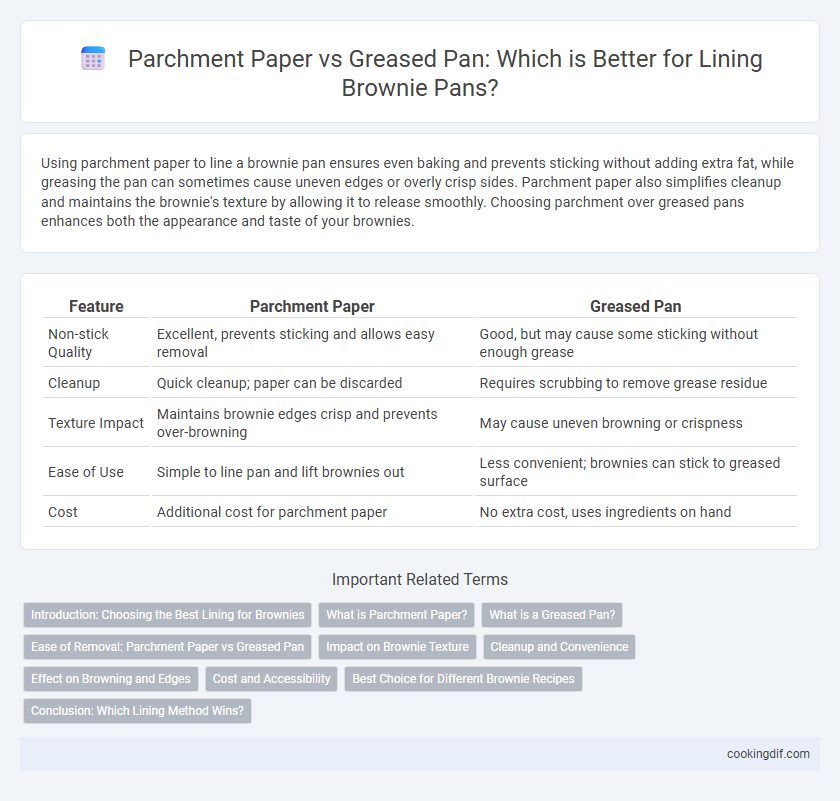Using parchment paper to line a brownie pan ensures even baking and prevents sticking without adding extra fat, while greasing the pan can sometimes cause uneven edges or overly crisp sides. Parchment paper also simplifies cleanup and maintains the brownie's texture by allowing it to release smoothly. Choosing parchment over greased pans enhances both the appearance and taste of your brownies.
Table of Comparison
| Feature | Parchment Paper | Greased Pan |
|---|---|---|
| Non-stick Quality | Excellent, prevents sticking and allows easy removal | Good, but may cause some sticking without enough grease |
| Cleanup | Quick cleanup; paper can be discarded | Requires scrubbing to remove grease residue |
| Texture Impact | Maintains brownie edges crisp and prevents over-browning | May cause uneven browning or crispness |
| Ease of Use | Simple to line pan and lift brownies out | Less convenient; brownies can stick to greased surface |
| Cost | Additional cost for parchment paper | No extra cost, uses ingredients on hand |
Introduction: Choosing the Best Lining for Brownies
Using parchment paper for lining brownie pans ensures easy removal and prevents sticking, maintaining the brownies' texture and shape. Greased pans provide a simple alternative but risk uneven cooking and potential sticking, which can compromise the brownie's edges and bottom. For optimal results, parchment paper is preferred due to its non-stick properties and ability to promote even baking.
What is Parchment Paper?
Parchment paper is a non-stick, heat-resistant baking sheet made from cellulose, often coated with silicone to prevent sticking and burning. It provides an easy release for brownies, ensuring clean edges and minimal mess without added grease. Using parchment paper enhances baking consistency and simplifies cleanup compared to a greased pan.
What is a Greased Pan?
A greased pan is a baking dish coated with butter, oil, or shortening to prevent brownies from sticking during baking. Unlike parchment paper, which provides a non-stick barrier and easy removal, greasing relies on a thin layer of fat to create a smooth surface. This method can affect the texture of brownie edges, often resulting in a slightly crisper crust.
Ease of Removal: Parchment Paper vs Greased Pan
Parchment paper offers superior ease of removal for brownies as it creates a non-stick barrier that prevents sticking and allows the entire batch to lift out cleanly. Greased pans can cause uneven sticking and may leave residue on the brownies, making slicing and serving more difficult. Using parchment paper ensures a smooth, hassle-free release and maintains the brownie's shape and texture.
Impact on Brownie Texture
Using parchment paper for lining brownie pans preserves moisture and prevents sticking, resulting in a fudgier and more evenly textured brownie. Greased pans can create a slightly crispier edge but may cause uneven browning or difficulty in clean removal, impacting the brownie's overall texture. Parchment paper facilitates easier lifting and slicing, maintaining the intended dense and chewy consistency without compromising structure.
Cleanup and Convenience
Using parchment paper for lining brownie pans significantly simplifies cleanup by preventing batter from sticking and eliminating the need for scrubbing. Greased pans may cause brownies to stick, making removal and washing more cumbersome. Parchment paper also offers convenience by allowing easy lifting of the entire brownie slab, speeding up the serving process.
Effect on Browning and Edges
Using parchment paper for lining brownie pans promotes even browning and prevents sticking, resulting in well-defined edges with a slightly crisper texture. Greasing the pan can cause uneven browning and softer edges, as the fat may create a barrier that inhibits proper caramelization. Parchment paper also allows for easier removal, preserving the brownies' shape and edge integrity.
Cost and Accessibility
Using parchment paper for lining brownie pans often costs more upfront than greasing a pan, but it provides consistent non-stick performance and easier cleanup. Greased pans, typically using butter or oil, are more accessible and budget-friendly since most kitchens already have these ingredients on hand. While parchment paper enhances convenience and reduces waste, greasing remains the most cost-effective and widely available method for home bakers.
Best Choice for Different Brownie Recipes
Parchment paper provides even heat distribution and easy removal, making it ideal for fudgy or delicate brownies that require gentle handling. Greased pans are better suited for cakey brownie recipes, ensuring a slightly crispier edge without sticking. Choosing between parchment paper and a greased pan depends on the desired texture and ease of cleanup for each specific brownie variety.
Conclusion: Which Lining Method Wins?
Parchment paper outperforms greased pans when lining for brownies due to its non-stick properties, ease of cleanup, and ability to prevent edges from becoming too greasy. It ensures even baking and maintains the integrity of delicate textures without altering flavor or adding extra fat. For consistently perfect brownies, parchment paper is the preferred choice among professional bakers and home cooks alike.
Parchment paper vs greased pan for lining Infographic

 cookingdif.com
cookingdif.com